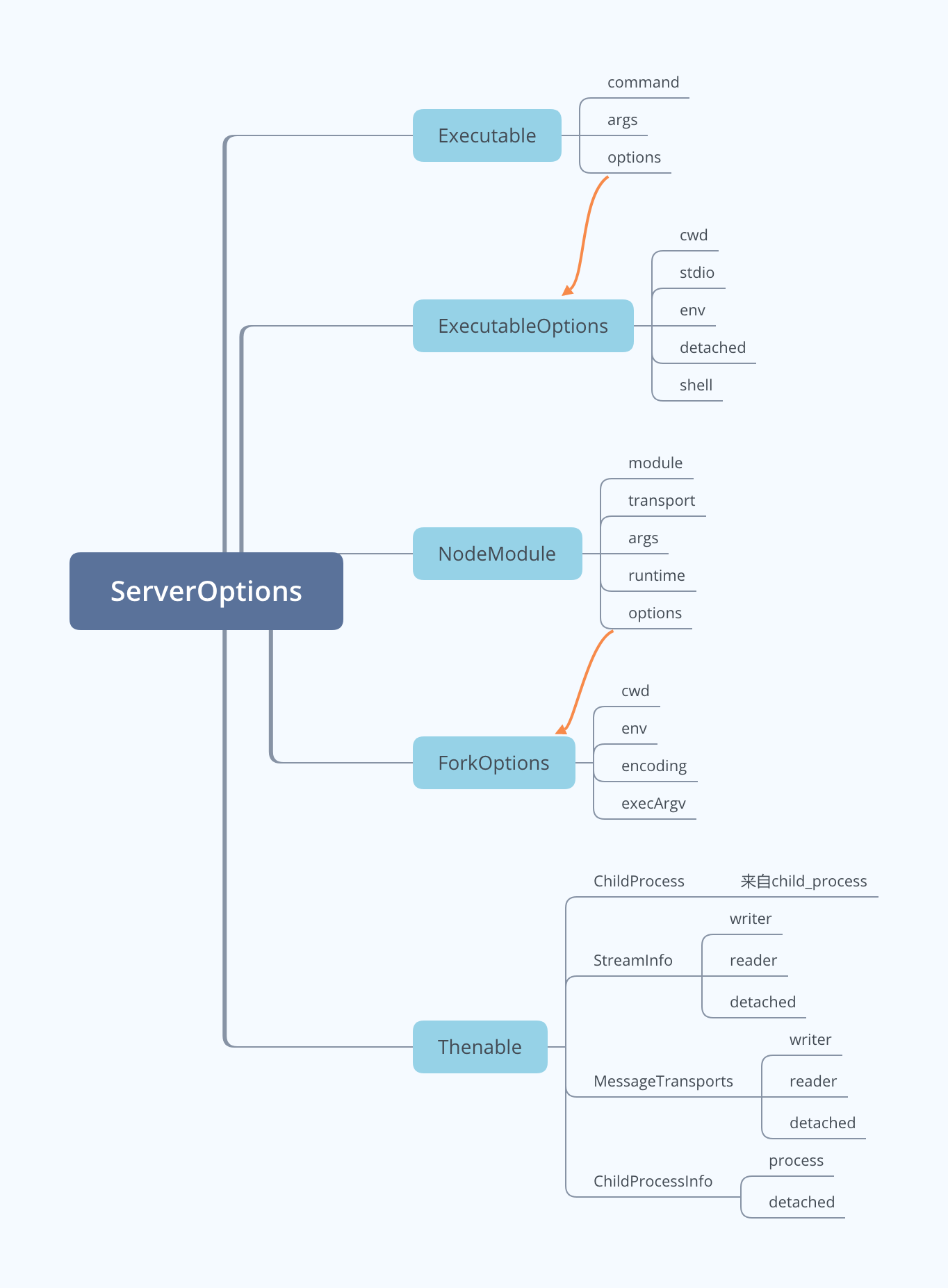vscode插件快餐教程(7) - 从头开始写一个完整的lsp工程
有了一定的基础知识之后,我们就可以开始搭建一个client和server模式的lsp的插件了。
server目录
首先我们来写server端的代码。
package.json
首先我们来写package.json. 因为微软的sdk已经帮我们封装好了大部分细节,其实我们只要引用vscode-languageserver的模块就可以了:
{
"name": "lsp-demo-server",
"description": "demo language server",
"version": "1.0.0",
"author": "Xulun",
"license": "MIT",
"engines": {
"node": "*"
},
"repository": {
"type": "git",
"url": "git@code.aliyun.com:lusinga/testlsp.git"
},
"dependencies": {
"vscode-languageserver": "^4.1.3"
},
"scripts": {}
}有了package.json之后,我们就可以在server目录下运行npm install命令将依赖安装进来。
安装之后会有下面的模块被引用进来:
- vscode-jsonrpc
- vscode-languageserver
- vscode-languageserver-protocol
- vscode-languageserver-types vscode-uri
tsconfig.json
因为我们是要用typescript来写server,所以我们用tsconfig.json来配置Typescript的选项:
{
"compilerOptions": {
"target": "es6",
"module": "commonjs",
"moduleResolution": "node",
"sourceMap": true,
"outDir": "out",
"rootDir": "src",
"lib": ["es6"]
},
"include": ["src"],
"exclude": ["node_modules", ".vscode-test"]
}server.ts
下面我们开始写服务端的ts文件,首先我们要把vscode-languageserver和vscode-jsonrpc的依赖引入进来:
import {
createConnection,
TextDocuments,
TextDocument,
Diagnostic,
DiagnosticSeverity,
ProposedFeatures,
InitializeParams,
DidChangeConfigurationNotification,
CompletionItem,
CompletionItemKind,
TextDocumentPositionParams,
SymbolInformation,
WorkspaceSymbolParams,
WorkspaceEdit,
WorkspaceFolder
} from 'vscode-languageserver';
import { HandlerResult } from 'vscode-jsonrpc';下面,为了打印日志方便,我们使用log4js来打印日志,通过npm i log4js --save将其模块引入进来,然后对其进行初始化:
import { configure, getLogger } from "log4js";
configure({
appenders: {
lsp_demo: {
type: "dateFile",
filename: "/Users/ziyingliuziying/working/lsp_demo",
pattern: "yyyy-MM-dd-hh.log",
alwaysIncludePattern: true,
},
},
categories: { default: { appenders: ["lsp_demo"], level: "debug" } }
});
const logger = getLogger("lsp_demo");然后我们就可以调用createConnection来创建连接了:
let connection = createConnection(ProposedFeatures.all);接着我们就可以处理一个个的事件啦,比如处理第6节介绍的初始化事件:
connection.onInitialize((params: InitializeParams) => {
let capabilities = params.capabilities;
return {
capabilities: {
completionProvider: {
resolveProvider: true
}
}
};
});三次握手之后,我们可以在vscode上显示一条消息:
connection.onInitialized(() => {
connection.window.showInformationMessage('Hello World! form server side');
});最后,我们可以把第5节学过的代码补全的部分给加上:
connection.onCompletion(
(_textDocumentPosition: TextDocumentPositionParams): CompletionItem[] => {
return [
{
label: 'TextView' + _textDocumentPosition.position.character,
kind: CompletionItemKind.Text,
data: 1
},
{
label: 'Button' + _textDocumentPosition.position.line,
kind: CompletionItemKind.Text,
data: 2
},
{
label: 'ListView',
kind: CompletionItemKind.Text,
data: 3
}
];
}
);
connection.onCompletionResolve(
(item: CompletionItem): CompletionItem => {
if (item.data === 1) {
item.detail = 'TextView';
item.documentation = 'TextView documentation';
} else if (item.data === 2) {
item.detail = 'Button';
item.documentation = 'JavaScript documentation';
} else if (item.data === 3) {
item.detail = 'ListView';
item.documentation = 'ListView documentation';
}
return item;
}
);client目录
服务端这就算开发就绪了,下面我们来开发客户端。
package.json
首先还是先写package.json,依赖于vscode-languageclient,不要跟服务端用的库vscode-languageserver搞混了哈。
{
"name": "lspdemo-client",
"description": "demo language server client",
"author": "Xulun",
"license": "MIT",
"version": "0.0.1",
"publisher": "Xulun",
"repository": {
"type": "git",
"url": "git@code.aliyun.com:lusinga/testlsp.git"
},
"engines": {
"vscode": "^1.33.1"
},
"scripts": {
"update-vscode": "vscode-install",
"postinstall": "vscode-install"
},
"dependencies": {
"path": "^0.12.7",
"vscode-languageclient": "^4.1.4"
},
"devDependencies": {
"vscode": "^1.1.30"
}
}tsconfig.json
反正都是ts,客户端与服务端比也没有增加啥特别的,于是照抄一份:
{
"compilerOptions": {
"module": "commonjs",
"target": "es6",
"outDir": "out",
"rootDir": "src",
"lib": ["es6"],
"sourceMap": true
},
"include": ["src"],
"exclude": ["node_modules", ".vscode-test"]
}extension.ts
下面我们来写extension.ts。
其实客户端要做的事情比server还少,本质上就是启动server就好:
// Create the language client and start the client.
client = new LanguageClient(
'DemoLanguageServer',
'Demo Language Server',
serverOptions,
clientOptions
);
// Start the client. This will also launch the server
client.start();serverOptions用来配置服务端的参数,其定义为:
export type ServerOptions =
Executable |
{ run: Executable; debug: Executable; } |
{ run: NodeModule; debug: NodeModule } |
NodeModule |
(() => Thenable<ChildProcess | StreamInfo | MessageTransports | ChildProcessInfo>);相关类型的简图如下:
下面我们来配置一下:
// 服务端配置
let serverModule = context.asAbsolutePath(
path.join('server', 'out', 'server.js')
);
let serverOptions: ServerOptions = {
module: serverModule, transport: TransportKind.ipc
};
// 客户端配置
let clientOptions: LanguageClientOptions = {
// js代码触发事情
documentSelector: [{ scheme: 'file', language: 'js' }],
};extension.ts的完整代码如下:
import * as path from 'path';
import { workspace, ExtensionContext } from 'vscode';
import {
LanguageClient,
LanguageClientOptions,
ServerOptions,
TransportKind
} from 'vscode-languageclient';
let client: LanguageClient;
export function activate(context: ExtensionContext) {
// 服务端配置
let serverModule = context.asAbsolutePath(
path.join('server', 'out', 'server.js')
);
let serverOptions: ServerOptions = {
module: serverModule, transport: TransportKind.ipc
};
// 客户端配置
let clientOptions: LanguageClientOptions = {
// js代码触发事情
documentSelector: [{ scheme: 'file', language: 'js' }],
};
client = new LanguageClient(
'DemoLanguageServer',
'Demo Language Server',
serverOptions,
clientOptions
);
// 启动客户端,同时启动语言服务器
client.start();
}
export function deactivate(): Thenable<void> | undefined {
if (!client) {
return undefined;
}
return client.stop();
}组装运行
万事俱备,只欠包装,下面我们将上面的客户端和服务器组装一下。
插件配置 - package.json
我们关注点主要是入口函数和触发事件:
"activationEvents": [
"onLanguage:javascript"
],
"main": "./client/out/extension",完整的package.json如下:
{
"name": "lsp_demo_server",
"description": "A demo language server",
"author": "Xulun",
"license": "MIT",
"version": "1.0.0",
"repository": {
"type": "git",
"url": "git@code.aliyun.com:lusinga/testlsp.git"
},
"publisher": "Xulun",
"categories": [],
"keywords": [],
"engines": {
"vscode": "^1.33.1"
},
"activationEvents": [
"onLanguage:javascript"
],
"main": "./client/out/extension",
"contributes": {},
"scripts": {
"vscode:prepublish": "cd client && npm run update-vscode && cd .. && npm run compile",
"compile": "tsc -b",
"watch": "tsc -b -w",
"postinstall": "cd client && npm install && cd ../server && npm install && cd ..",
"test": "sh ./scripts/e2e.sh"
},
"devDependencies": {
"@types/mocha": "^5.2.0",
"@types/node": "^8.0.0",
"tslint": "^5.11.0",
"typescript": "^3.1.3"
}
}装配tsconfig.json
我们还需要一个总的tsconfig.json,引用client和server两个目录:
{
"compilerOptions": {
"module": "commonjs",
"target": "es6",
"outDir": "out",
"rootDir": "src",
"lib": [ "es6" ],
"sourceMap": true
},
"include": [
"src"
],
"exclude": [
"node_modules",
".vscode-test"
],
"references": [
{ "path": "./client" },
{ "path": "./server" }
]
}配置vscode
上面,我们就将client, server和整合它们的代码全部写完了。
下面我们在.vscode目录中写两个配置文件,使我们可以更方便地调试和运行。
.vscode/launch.json
有了这个文件之后,我们就有了运行的配置,可以通过F5来启动。
// A launch configuration that compiles the extension and then opens it inside a new window
{
"version": "0.2.0",
"configurations": [
{
"type": "extensionHost",
"request": "launch",
"name": "Launch Client",
"runtimeExecutable": "${execPath}",
"args": ["--extensionDevelopmentPath=${workspaceRoot}"],
"outFiles": ["${workspaceRoot}/client/out/**/*.js"],
"preLaunchTask": {
"type": "npm",
"script": "watch"
}
},
{
"type": "node",
"request": "attach",
"name": "Attach to Server",
"port": 6009,
"restart": true,
"outFiles": ["${workspaceRoot}/server/out/**/*.js"]
},
],
"compounds": [
{
"name": "Client + Server",
"configurations": ["Launch Client", "Attach to Server"]
}
]
}.vscode/tasks.json
配置npm compile和npm watch两个脚本。
{
"version": "2.0.0",
"tasks": [
{
"type": "npm",
"script": "compile",
"group": "build",
"presentation": {
"panel": "dedicated",
"reveal": "never"
},
"problemMatcher": [
"$tsc"
]
},
{
"type": "npm",
"script": "watch",
"isBackground": true,
"group": {
"kind": "build",
"isDefault": true
},
"presentation": {
"panel": "dedicated",
"reveal": "never"
},
"problemMatcher": [
"$tsc-watch"
]
}
]
}一切就绪之后,在插件根目录下运行下npm install。
然后在vscode中运行build命令,比如mac下是cmd-shift-b,于是就构建生成了server和client的out目录下的js和map。
现在就可以通过F5键运行啦。
本示例的源代码放在code.aliyun.com:lusinga/testlsp.git中。